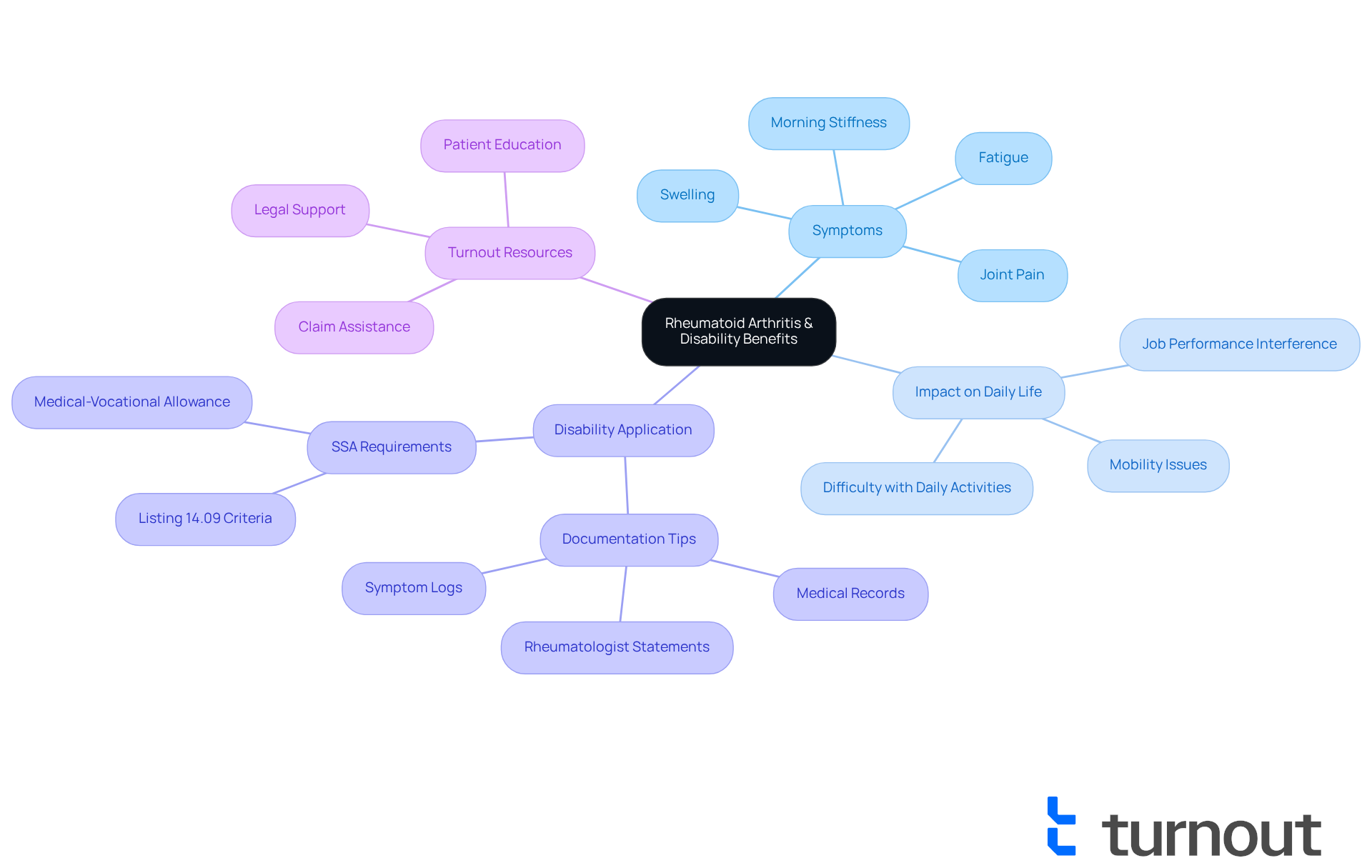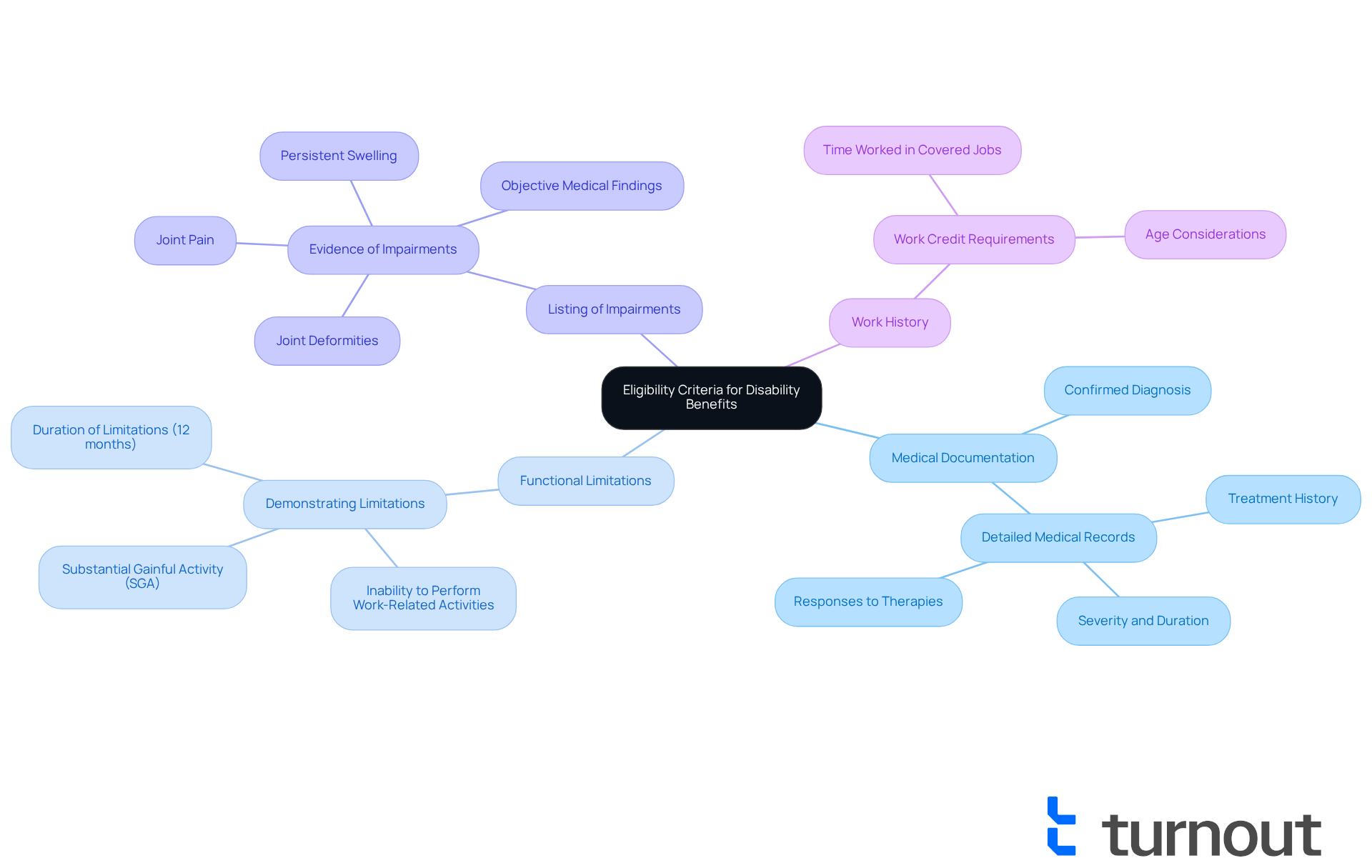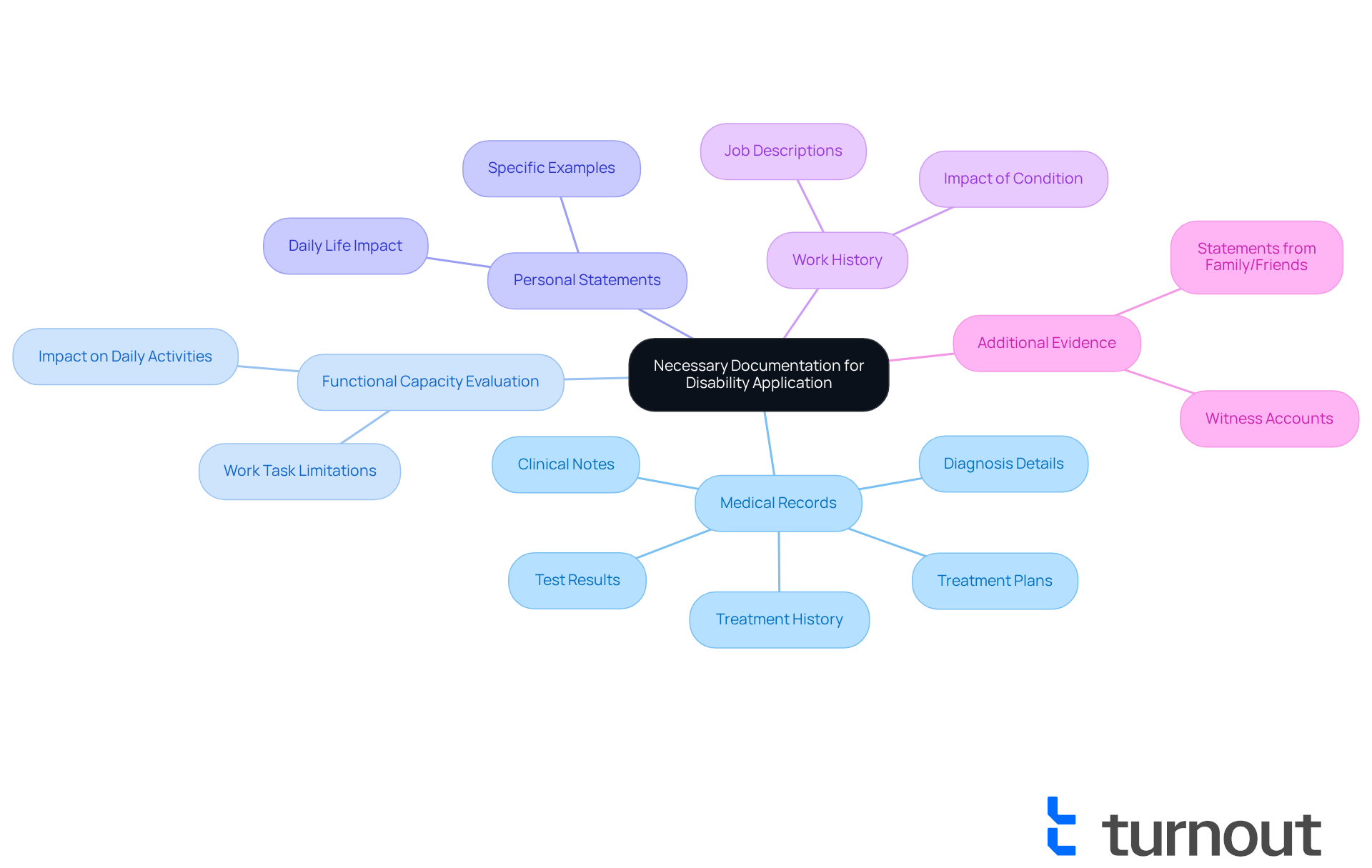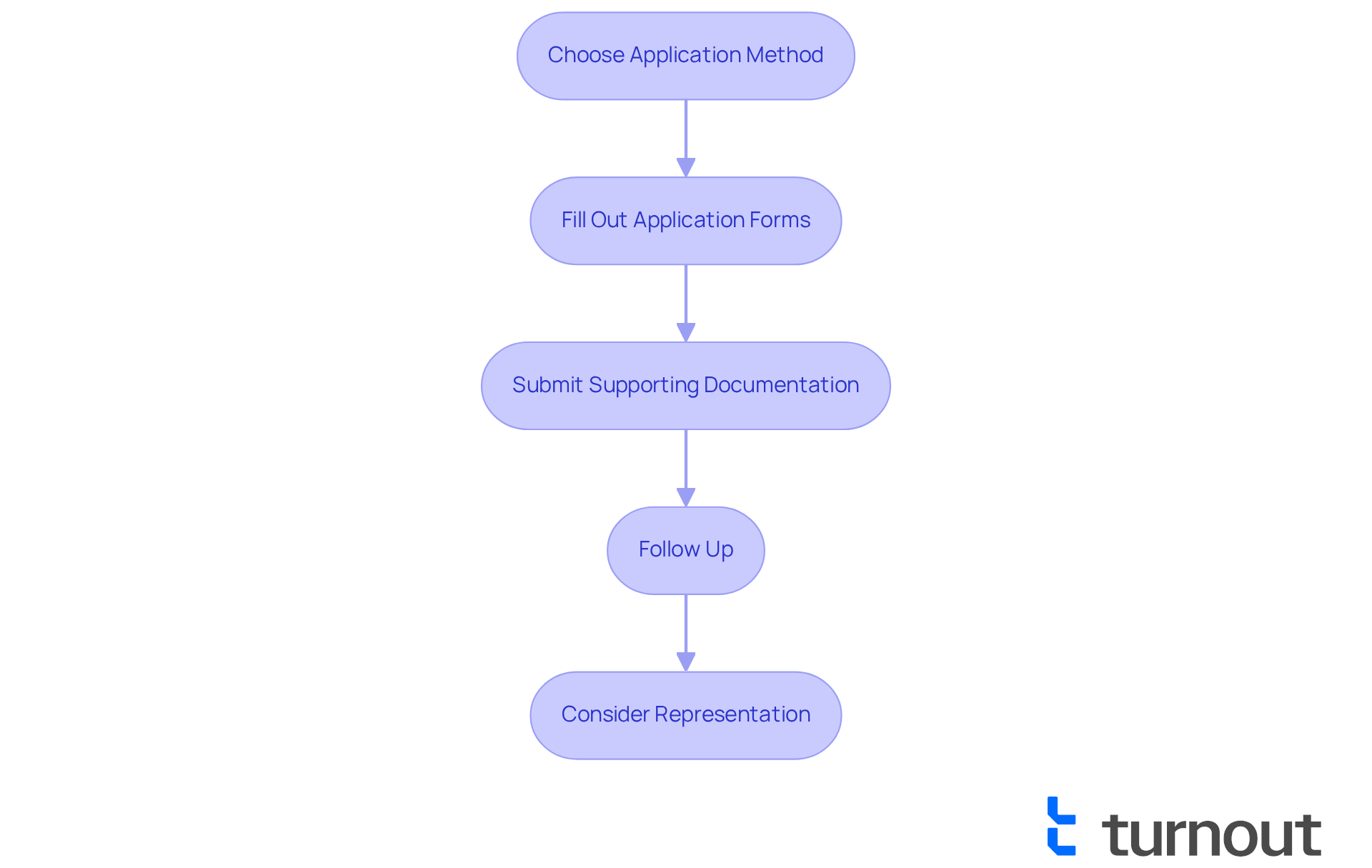Overview
Navigating the process of securing disability benefits can feel overwhelming, especially for those facing the challenges of rheumatoid arthritis. Understanding the eligibility criteria is the first essential step. Gathering the necessary documentation is crucial, as it forms the backbone of your application. Completing the application process can seem daunting, but it is a vital part of your journey.
To support your case, it's important to know the specific medical and functional evidence required by the Social Security Administration. This includes documentation that clearly outlines your condition and its impact on your daily life. We understand that presenting your case effectively can significantly improve your chances of approval.
Remember, you are not alone in this journey. We're here to help you through each step, ensuring you have the guidance and support you need. By taking these steps, you can move closer to securing the benefits you deserve.
Introduction
Rheumatoid arthritis (RA) presents a relentless challenge, affecting not just joints but also the overall quality of life for those who suffer from it. We understand that grappling with the debilitating symptoms of RA can be overwhelming.
Navigating the pathway to securing disability benefits is a crucial yet daunting endeavor for many. This article explores the essential steps needed to apply for disability with rheumatoid arthritis, addressing:
- Eligibility criteria
- Necessary documentation
- The application process itself
How can you effectively demonstrate the profound impact of your condition on your daily life and work capabilities? Together, we can enhance your chances of approval.
Understand Rheumatoid Arthritis and Its Implications for Disability Benefits
Rheumatoid arthritis (RA) is a chronic inflammatory disorder that primarily affects joints but can also impact other systems in the body. We understand that living with RA can be challenging, as it is characterized by painful swelling, stiffness, and potential joint damage. These symptoms can severely limit your mobility and functionality, making daily activities feel daunting.
Comprehending the implications of RA is crucial for individuals pursuing disability with rheumatoid arthritis assistance. The Social Security Administration (SSA) requires proof that your disability with rheumatoid arthritis significantly hinders your ability to work. Symptoms such as fatigue, joint pain, and morning stiffness can interfere with job performance and everyday tasks for those facing a disability with rheumatoid arthritis. It's vital to document these effects thoroughly when applying for benefits.
Turnout offers essential resources and services to assist you in managing the intricacies of SSD claims. We’re here to help ensure that your submission illustrates the genuine impact of RA on your life. Recognizing how RA affects your daily activities will empower you to articulate your situation more effectively in your application. With Turnout's support, you can approach this process with confidence, knowing you are not alone in this journey.

Identify Eligibility Criteria for Disability Benefits with Rheumatoid Arthritis
Navigating the process of qualifying for disability benefits due to arthritis can be overwhelming, but understanding the specific criteria set by the Social Security Administration (SSA) can make a significant difference. Here’s what you need to know:
-
Medical Documentation: It’s essential to have a confirmed diagnosis of inflammatory arthritis from a qualified healthcare provider. This should include detailed medical records that outline the severity and duration of your condition, along with your treatment history and responses to therapies.
-
Functional Limitations: You’ll need to show how rheumatoid arthritis (RA) limits your ability to perform work-related activities. This means demonstrating that your condition prevents you from engaging in substantial gainful activity (SGA) for at least 12 months. Highlight specific tasks you can no longer perform due to pain or physical limitations.
-
Listing of Impairments: The SSA has a specific listing for immune system disorders, including rheumatoid arthritis. To qualify under this listing, you must provide evidence of persistent swelling, pain, and joint deformities that significantly impair your functional capacity, supported by objective medical findings.
-
Work History: Additionally, you must meet work credit requirements based on your age and the amount of time you have worked in jobs covered by Social Security. This ensures that you have made contributions to the system and qualify for assistance based on your work history.
Understanding these criteria is crucial for effectively preparing your application and increasing your chances of approval. Proper medical documentation and a clear demonstration of how RA affects your daily functioning can significantly enhance the likelihood of a successful claim. Remember, you are not alone in this journey; we’re here to help you every step of the way.

Gather Necessary Documentation for Your Application
When seeking disability benefits due to arthritis, we understand that collecting thorough documentation can feel overwhelming. However, having the right documents is essential to support your claim. Here are the key documents you will need:
-
Medical Records: It's crucial to obtain records from your healthcare provider that detail your diagnosis, treatment history, and the progression of your condition. This should include clinical notes from visits, test results (e.g., blood tests, imaging studies), and treatment plans along with responses to medications.
-
Functional Capacity Evaluation: A report from a healthcare expert evaluating how arthritis impacts your ability to carry out daily activities and work tasks can be beneficial.
-
Personal Statements: Consider writing a personal statement that details how disability with rheumatoid arthritis affects your daily life. Including specific examples of the limitations you face in work and personal activities caused by your disability with rheumatoid arthritis can be very impactful.
-
Work History: Document your work history, including job descriptions and how your condition has affected your ability to perform your job duties.
-
Additional Evidence: You might also think about including statements from family members or friends who can attest to the impact of your condition on your daily life.
Gathering these documents thoroughly will enhance your submission and offer the Social Security Administration (SSA) a clear view of your circumstances. Statistics indicate that thorough medical documentation significantly enhances the chances of approval, as the SSA requires clear and substantial evidence to make informed decisions regarding eligibility. By maintaining open communication with healthcare providers and ensuring accurate records, you can effectively advocate for your rights and improve your likelihood of receiving the benefits you deserve. Remember, if your initial request is denied, do not give up; persistence is key in navigating the claims process. You are not alone in this journey, and we are here to help you every step of the way.

Complete the Disability Application Process for Rheumatoid Arthritis
Completing the disability application process for disability with rheumatoid arthritis can feel overwhelming, but we are here to guide you through it. By following these key steps, you can navigate the process with greater confidence.
-
Choose Your Application Method: You have options when applying for Social Security Disability Insurance (SSDI). You can apply online at the SSA website, by phone, or in person at your local SSA office. Choose the method that feels most comfortable for you.
-
Fill Out the Application Forms: Take your time to complete the necessary forms. It's important to provide detailed information about your medical condition, work history, and how disability with rheumatoid arthritis impacts your daily life. Remember, being thorough and honest in your responses is crucial for your submission.
-
Submit Supporting Documentation: Gather and attach all relevant documentation, including medical records and personal statements. Make sure everything is organized and clearly labeled. Strong medical documentation can significantly speed up the approval process, so this step is vital.
-
Follow Up: After submitting your request, keep an eye on its status. It’s common to receive requests for additional information or documentation from the SSA, so be ready to respond promptly to avoid any delays.
-
Consider Representation: If at any point you feel overwhelmed, remember that seeking assistance from a qualified advocate can be incredibly helpful. Research shows that applicants with trained nonlegal advocates are three times more likely to secure assistance. These advocates can help you navigate the complexities of the application process and increase your chances of approval.
By carefully following these steps, you can enhance your chances of securing the disability benefits you need for disability with rheumatoid arthritis. It's important to remember that the average wait time for a decision can exceed seven months, so starting the process as soon as possible is essential. You are not alone in this journey, and there are resources available to support you every step of the way.

Conclusion
Navigating the complexities of securing disability benefits due to rheumatoid arthritis can feel overwhelming. Many individuals face this challenging condition, and understanding the implications of RA is crucial. Identifying eligibility criteria, gathering necessary documentation, and completing the application process are essential steps that can significantly enhance the likelihood of approval. Each of these components plays a vital role in illustrating the profound impact RA has on daily life and work capabilities.
Key insights throughout this article highlight the importance of thorough medical documentation and a clear demonstration of functional limitations. Support systems during the application process are invaluable. By meticulously preparing each aspect of the claim, you can present a compelling case that aligns with the Social Security Administration's requirements. Remember, seeking assistance from advocates can make a world of difference in navigating this often overwhelming process.
Ultimately, the journey to secure disability benefits for rheumatoid arthritis is not just about meeting criteria. It’s about advocating for your needs and rights. We understand that this process can be daunting, but it’s essential to approach it with determination and the knowledge that support is available. Taking proactive steps today can pave the way for a more secure tomorrow, empowering you to reclaim your life amidst the challenges of rheumatoid arthritis.
Frequently Asked Questions
What is rheumatoid arthritis (RA)?
Rheumatoid arthritis (RA) is a chronic inflammatory disorder that primarily affects joints but can also impact other systems in the body, causing painful swelling, stiffness, and potential joint damage.
How does RA affect daily life?
RA can severely limit mobility and functionality, making daily activities feel daunting due to symptoms like fatigue, joint pain, and morning stiffness.
What are the implications of RA for disability benefits?
Individuals pursuing disability benefits for RA must provide proof that the condition significantly hinders their ability to work, as required by the Social Security Administration (SSA).
What symptoms should be documented when applying for disability benefits due to RA?
Symptoms such as fatigue, joint pain, and morning stiffness should be thoroughly documented, as they can interfere with job performance and everyday tasks.
How can Turnout assist individuals with RA in applying for disability benefits?
Turnout offers essential resources and services to help manage the complexities of SSD claims, ensuring that submissions effectively illustrate the impact of RA on individuals' lives.
Why is it important to understand how RA affects daily activities when applying for benefits?
Understanding how RA impacts daily activities empowers individuals to articulate their situation more effectively in their disability application, which can improve their chances of approval.




